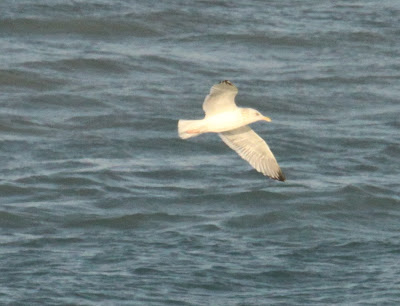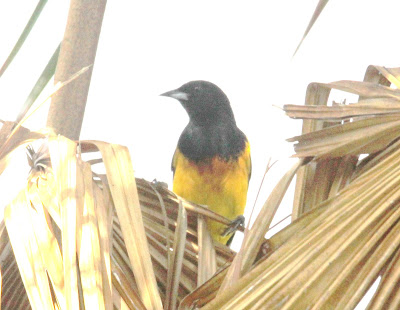A great
feeling to be back in The Yucatan, but no dreams
this time of Chechen Itza, as Billy Crumble and I did back in 2004. No,
armed
with some very useful information, provided by Birding Pal Bev who was
traveling in Cuba so unable to guide me, it was to be a day amid the
ruins of
a far smaller and less well known Mayan complex and the adjacent ‘salt
pans’.
However, there was one small snag before visiting either as the docks
were
simply full of birds which were hard to drag myself away from.
Out of a radient sunrise came he ever reliable
PILOT BOAT
this time, and strangely, escorted by a military power boat of sorts?
On the way to the berth there was a flotilla of birds including
these splendid LAUGHING GULLs
Magnificent Frigatebirds, Royal Terns etc.
Not too sure about status of the so called CABOT'S TERN but more of that later.
This
is the first MAGNIFICENT FRIGATEBIRD we have noted with any 'red' about
it. Throat pouch getting ready for a bit of serious nonsense I guess?
AMERICAN HERRING GULL
was
an addition to the 'Trip List' and later in the day there were a good
number of 'first winter' juveniles but none within photographic range.
So,
back to CABOT'S TERN, with this looking every bit like a Sandwich Tern
to me. However, they say there is, or was, a debate going on to 'split'
the two??
Most obliging nonetheless!
Here's one for the Lifton's, do you have this as part of your LIGHTHOUSE FAMILY?
So,
eventually we got alongside to a warm welcome from even more LAUGHING
GULLs and the odd DOUBLE-CRESTED CORMORANT. The same old banter followed
in an effort to agree a price on the taxi, with them wanting $1,000 and
me wanting a 'free' ride, $50 sounded good for all day.
On the way to the ruins, the salt pans held a good number of
GREATER FLAMINGOs, these few being close at hand.
At the destination
once again I was short of a small camera,
an item you would have thought easy to purchase on such a trip,
but no so the views are a little stinted to say the least.
First to show were this pair of
AZTEC
PARAKEET, which was thought to be a prospective 'lifer' until
consulting the book to find that they and Olive-throated are one and the
same bird.
Next on scene
YUCATAN WOODPECKER
and in the depths of the 'wet ' forest
PALM WARBLER
First 'lifer' of the day was GREY-CROWNED YELLOWTHROAT
followed by splendid male AMERICAN REDSTART
and NORTHERN PARULA
What came next I still don't know
just don't seem to be able to find this in the book.
Any ideas, answers on a postcard please!
TROPICAL KINGBIRDs were all over the place as were
3 species of Oriole, this one being BLACK-VENTED ORIOLE
the other 2 being Hooded and Orange.
GROOVE-BILLED ANI were also numerous
but the lower bird in this shot (in company with a YELLOW-RUMPED CACIQUE) was not picked up until editing and thought to be
YELLOW-BACKED ORIOLE
SOCIAL FLYCATCHER were
as the name suggests, 'social' and numbered about the same as close relative the
GREAT KISKADEE
Finally, for this half of the story at least, we leave you with the ubiquitous TROPICAL MOCKINGBIRD.














































